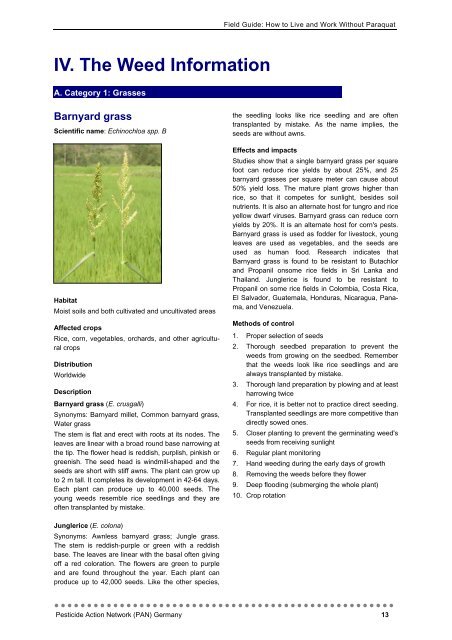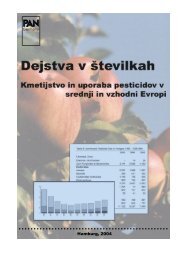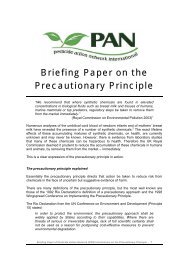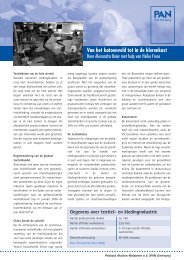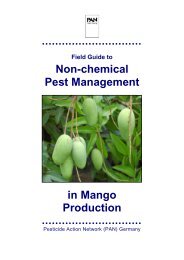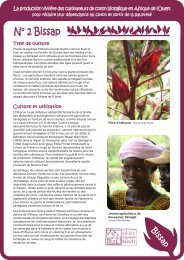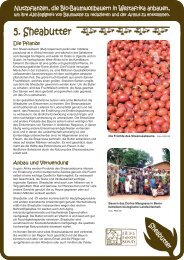Field Guide: How to Grow Crops without Paraquat - Online ...
Field Guide: How to Grow Crops without Paraquat - Online ...
Field Guide: How to Grow Crops without Paraquat - Online ...
You also want an ePaper? Increase the reach of your titles
YUMPU automatically turns print PDFs into web optimized ePapers that Google loves.
<strong>Field</strong> <strong>Guide</strong>: <strong>How</strong> <strong>to</strong> Live and Work Without <strong>Paraquat</strong><br />
IV. The Weed Information<br />
A. Category 1: Grasses<br />
Barnyard grass<br />
Scientific name: Echinochloa spp. B<br />
Habitat<br />
Moist soils and both cultivated and uncultivated areas<br />
Affected crops<br />
Rice, corn, vegetables, orchards, and other agricultural<br />
crops<br />
Distribution<br />
Worldwide<br />
Description<br />
Barnyard grass (E. crusgalli)<br />
Synonyms: Barnyard millet, Common barnyard grass,<br />
Water grass<br />
The stem is flat and erect with roots at its nodes. The<br />
leaves are linear with a broad round base narrowing at<br />
the tip. The flower head is reddish, purplish, pinkish or<br />
greenish. The seed head is windmill-shaped and the<br />
seeds are short with stiff awns. The plant can grow up<br />
<strong>to</strong> 2 m tall. It completes its development in 42-64 days.<br />
Each plant can produce up <strong>to</strong> 40,000 seeds. The<br />
young weeds resemble rice seedlings and they are<br />
often transplanted by mistake.<br />
the seedling looks like rice seedling and are often<br />
transplanted by mistake. As the name implies, the<br />
seeds are <strong>without</strong> awns.<br />
Effects and impacts<br />
Studies show that a single barnyard grass per square<br />
foot can reduce rice yields by about 25%, and 25<br />
barnyard grasses per square meter can cause about<br />
50% yield loss. The mature plant grows higher than<br />
rice, so that it competes for sunlight, besides soil<br />
nutrients. It is also an alternate host for tungro and rice<br />
yellow dwarf viruses. Barnyard grass can reduce corn<br />
yields by 20%. It is an alternate host for corn's pests.<br />
Barnyard grass is used as fodder for lives<strong>to</strong>ck, young<br />
leaves are used as vegetables, and the seeds are<br />
used as human food. Research indicates that<br />
Barnyard grass is found <strong>to</strong> be resistant <strong>to</strong> Butachlor<br />
and Propanil onsome rice fields in Sri Lanka and<br />
Thailand. Junglerice is found <strong>to</strong> be resistant <strong>to</strong><br />
Propanil on some rice fields in Colombia, Costa Rica,<br />
El Salvador, Guatemala, Honduras, Nicaragua, Panama,<br />
and Venezuela.<br />
Methods of control<br />
1. Proper selection of seeds<br />
2. Thorough seedbed preparation <strong>to</strong> prevent the<br />
weeds from growing on the seedbed. Remember<br />
that the weeds look like rice seedlings and are<br />
always transplanted by mistake.<br />
3. Thorough land preparation by plowing and at least<br />
harrowing twice<br />
4. For rice, it is better not <strong>to</strong> practice direct seeding.<br />
Transplanted seedlings are more competitive than<br />
directly sowed ones.<br />
5. Closer planting <strong>to</strong> prevent the germinating weed's<br />
seeds from receiving sunlight<br />
6. Regular plant moni<strong>to</strong>ring<br />
7. Hand weeding during the early days of growth<br />
8. Removing the weeds before they flower<br />
9. Deep flooding (submerging the whole plant)<br />
10. Crop rotation<br />
Junglerice (E. colona)<br />
Synonyms: Awnless barnyard grass; Jungle grass.<br />
The stem is reddish-purple or green with a reddish<br />
base. The leaves are linear with the basal often giving<br />
off a red coloration. The flowers are green <strong>to</strong> purple<br />
and are found throughout the year. Each plant can<br />
produce up <strong>to</strong> 42,000 seeds. Like the other species,<br />
••••••••••••••••••••••••••••••••••••••••••••••••••••<br />
Pesticide Action Network (PAN) Germany 13


